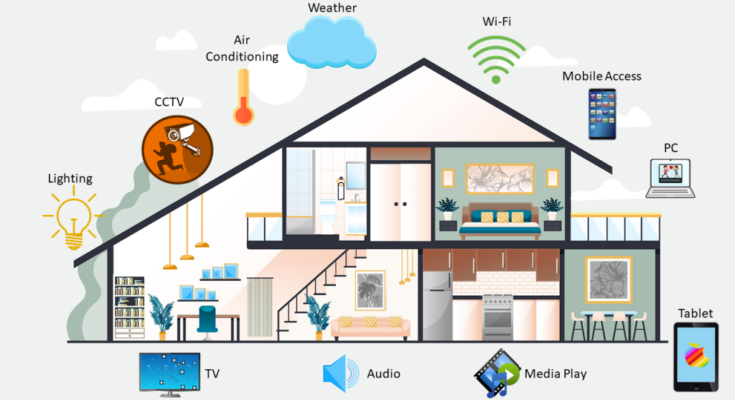A New Era of Home Living
Welcome to the future, where your home isn’t just a place to live but a smart, connected sanctuary. Smart home technology has revolutionized the way we interact with our living spaces, turning ordinary homes into efficient, secure, and convenient environments. Whether you’re a homeowner, a tech enthusiast, or someone looking to enhance family life, this guide will show you how to create a connected home that’s both futuristic and functional.
The Evolution of Smart Homes
A Brief History
The concept of smart homes isn’t entirely new. It dates back to the late 20th century when early adopters began experimenting with home automation systems. These rudimentary technologies laid the groundwork for today’s sophisticated smart devices, which offer seamless integration and control over various aspects of home life.
Defining a Connected Home
A connected home goes beyond basic automation. It’s a network of devices and systems that communicate with each other to provide a cohesive living experience. From controlling your lighting and climate to managing security and entertainment, a connected home offers unparalleled convenience and efficiency.
The Benefits of a Smart Home
Convenience and Time-Saving Features
Imagine waking up to a home that prepares itself for your day. Smart home technology can automate routine tasks, such as adjusting the thermostat, brewing your coffee, and even reminding you of your schedule. Voice-activated assistants like Amazon Alexa and Google Home make it easier to manage these tasks with simple voice commands.
Enhanced Security and Safety
Security is a top priority for any homeowner. Smart home systems offer advanced security features like real-time surveillance, motion detectors, and smart locks. These devices not only deter potential intruders but also provide peace of mind by allowing you to monitor your home remotely.
Energy Efficiency and Cost Savings
Smart home technology can significantly reduce your energy consumption. Smart thermostats learn your habits and adjust heating and cooling settings accordingly, while smart lighting systems ensure that lights are only on when needed. These energy-efficient practices not only lower your utility bills but also contribute to a more sustainable environment.
Components of a Smart Home
Smart Lighting and Switches
Smart lighting systems allow you to control the lighting in your home via your smartphone or voice commands. You can set schedules, dim lights, and even change colors to suit your mood. Smart switches offer similar benefits, allowing you to control non-smart devices remotely.
Home Automation Systems
Home automation systems serve as the backbone of a smart home. These systems integrate various smart devices, enabling them to work together seamlessly. Platforms like Apple HomeKit, Samsung SmartThings, and Google Nest offer centralized control over your home’s automation, making it easier to manage everything from one place.
Smart Appliances and Entertainment
Smart appliances, such as refrigerators, ovens, and washing machines, can make household chores more manageable. These devices often come with features like remote control, monitoring, and even recipe suggestions. Smart entertainment systems, including smart TVs and speakers, provide immersive experiences and easy access to streaming services.
How to Make Your Home Smarter
Steps for Beginners
Starting your smart home journey can be overwhelming, but it doesn’t have to be. Begin with basic, user-friendly devices like smart plugs and bulbs. These entry-level products are easy to install and provide immediate benefits. Gradually expand your setup by incorporating more complex devices like smart thermostats and security cameras.
Advanced Smart Home Upgrades
Once you’re comfortable with the basics, consider advanced upgrades. Invest in a comprehensive home automation system to integrate your devices. Explore options like smart locks and video doorbells for enhanced security. For the ultimate smart home experience, think about installing a smart home hub that can control all your devices from a single interface.
Challenges and Considerations
Privacy and Security Concerns
While smart home technology offers numerous benefits, it also raises privacy and security concerns. Cybersecurity threats are a real risk, so it’s crucial to choose devices with robust security features. Regularly update your devices and use strong, unique passwords to protect your connected home from potential breaches.
Compatibility and Integration Issues
Not all smart devices are compatible with each other, which can make integration challenging. Before purchasing new devices, ensure they are compatible with your existing systems. Opt for products that work with major home automation platforms to minimize compatibility issues and simplify integration.
The Future of Smart Home Technology
Emerging Trends and Innovations
The future of smart home technology is incredibly promising. Innovations like AI-powered personal assistants, smart home robotics, and advanced energy management systems are on the horizon. These emerging trends will further enhance the efficiency, security, and convenience of connected homes, making them an integral part of modern living.
A Connected Tomorrow
Smart home technology is transforming how we live, offering a blend of convenience, security, and efficiency. By understanding the benefits and challenges of creating a connected home, you can make informed decisions that enhance your lifestyle. Ready to take the next step? Explore smart home options today and join the growing community of tech-savvy homeowners. Share this post with friends and family interested in making their homes smarter, and start your journey towards a connected tomorrow.


